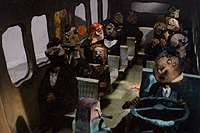|
|
ANIMATION WORLD MAGAZINE - ISSUE 4.8 - NOVEMBER 1999
The CNC: A Complete Support Systemby Valérie Rivoallon The National Center of Cinematography, or CNC, was created in France in 1946. Situated under the aegis of the Ministry of Culture, its prime objectives are the economic support, promotion and distribution of films and audiovisual presentations, as well as the primary and continuing education of its professionals. [Editor's Note: It is interesting to note that some of the funding for the CNC comes directly from theater ticket sales. People attending the cinema, automatically contribute to the continuation of the long standing French cinematic tradition.] Along with live-action fiction and documentary, animation receives various benefits distributed according to the nature of the program: film, television or multimedia. Funding is distributed by the CNC in two ways: either by a juried, or selective, process where a committee decides, or by "automatic aid," which means that all companies and individuals meeting CNC's criteria and regulations are eligible.
For film projects, the Cultural Action Services and Selected Aid Services share certain sums allotted specially to feature-length and short films. As far as the features go, there are two types of support: development loans, which must be later repaid, to invest in the various phases of writing, optioning rights for adaptation, research and documentation, and storyboards; and production grants, which can be attained either before or after production begins, and are leveraged against future profits. As for short films (films less than one hour in length) pre-production grants take the form of financial contributions given after two review committees have evaluated a production file submitted by the filmmakers. These production proposals are first submitted to a reading committee consisting of five animation professionals (directors, producers, teachers, critics, etc.), then they are mixed in with scripts for live-action and documentary projects to appear before a bigger panel which includes professionals and representatives from television networks. There is also a bonus for quality films that already have a distribution agreement and an authorization for production.
In 1998, projects by Manuel Otero (The Mystery of Fertile Valley) and Jacques-Remy Girerd (The Prophecy of the Frogs) benefited from economic support for the development of feature-length films. The film The Triplets of Belleville by Sylvain Chomet received a promise of an advance, while six short animations received selective funding, and two others were tapped for quality. Funding is limited to 60 different short films of all kinds each year.
In order to encourage production, the heads
of the Cultural and Territorial Affairs department have also contributed
their support to two projects which have by now proven their viability.
The Center for First Works (CPO) is thus managed jointly by the
CNC and the Paris Chamber of Commerce and Industry, via CFT Gobelins'
School of the Image. They welcome projects from young artists who
want to use animation techniques to make short films. Once the preliminary
estimate of the cost of the project is accepted, the production
is supervised by someone from the school, who serves as the director
of production, as well as technical advisor. |
| 1 | 2 |
Note: Readers may contact any Animation World Magazine contributor by sending an e-mail to editor@awn.com.


